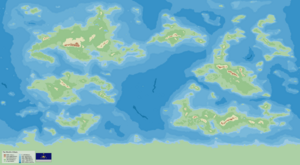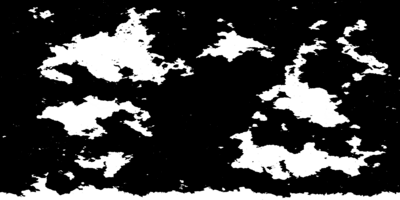Elezia
This page contains the canonical information about the planet Elezia, if you are looking for regional information look at Elezia (Region) or Portal:Elezia.
 A basic relief map of Elezia. | |||||||||||||
| Designations | |||||||||||||
|---|---|---|---|---|---|---|---|---|---|---|---|---|---|
| The World | |||||||||||||
| Orbital characteristics | |||||||||||||
| Epoch A2000 | |||||||||||||
| Aphelion | 152100000 km (94500000 mi) | ||||||||||||
| Perihelion | 147095000 km (91401000 mi) | ||||||||||||
| 149598023 km (92955902 mi) | |||||||||||||
| Eccentricity | ~0.0167086 | ||||||||||||
| 365 d (12.0 months) | |||||||||||||
Average orbital speed | 29.78 km/s (18.50 mi/s) | ||||||||||||
| 358.617° | |||||||||||||
| Physical characteristics | |||||||||||||
Equatorial radius | 6378.1 km (3963.2 mi) | ||||||||||||
Polar radius | 6356.8 km (3949.9 mi) | ||||||||||||
| Flattening | 0.0033528 | ||||||||||||
| Circumference | 40075.017 km (24901.461 mi) (equatorial) 40007.86 km (24859.73 mi) (meridional) | ||||||||||||
| 510,072,000km2 (316,944,000 mi2) | |||||||||||||
| Volume | 1.08321 × 1012km3 | ||||||||||||
| Mass | 5.97237 x 1024 kg | ||||||||||||
Mean density | 5.514 g/cm3 | ||||||||||||
| 9.807 m/s2 | |||||||||||||
| 0.3307 | |||||||||||||
| 11.186 km/s (6.951 mi/s) | |||||||||||||
Sidereal rotation period | 0.99726968 d (23.934472 h) | ||||||||||||
Equatorial rotation velocity | 0.4651 km/s (0.2890 mi/s) | ||||||||||||
| 23.4392811° | |||||||||||||
| Albedo | 0.367 geometric 0.306 Bond | ||||||||||||
| |||||||||||||
| Atmosphere | |||||||||||||
Surface pressure | 101.325 kPa (at MSL) | ||||||||||||
| Composition by volume | 78.08% nitrogen (N2) (dry air) 20.95% oxygen (O2) 0.930% argon 0.039% carbon dioxide (climate-variable) | ||||||||||||
Elezia, or the Aerth (Anglish) or Tierra (Almagrian) is the fourth planet from the Sol. It is the only known planet to accommodate life. There are around 8 million different plant and animal species around the World. Scientific analysis has concluded that Elezia formed and developed over 4 billion years ago. The Aerth rotates around the Sol in 365 and ¼ days, a period commonly accepted as an Aerth year. The Aerth's surface layer is formed of several slowly moving tectonic plates, interacting to produce mountain ranges, volcanoes, and erthquakes. The Aerth's liquid outer core generates the magnetic field that shapes Aerth's magnetosphere, deflecting destructive solar winds.
The atmosphere on the Aerth is made up of mostly nitrogen and oxygen. More solar energy is received by tropical regions than polar regions and is redistributed by atmospheric and ocean circulation. Water vapor is widely present in the atmosphere and forms clouds that cover most of the planet.
The planet contains a variety of different nations and civilisations that inhabit the landmasses, which are home to many different vibrant cultures and languages. The planet is home to roughly 6 billion people, as of 2022.
Etymology
Geography
| Map of the Continents | Continent | Approx. total area | |
|---|---|---|---|
| Parthenia | X | ||
| Atusia | X | ||
| Muanbia | X | ||
| Triania | X | ||
| Triania Minor | X | ||
| Tarandra | X |
Continents
Parthenia
The Parthenian continent is located entirely within the northern hemisphere, located to the west of the Merillian Ocean and to the east of the Sarosan Ocean. It lies just north of continental Tarandra and the Aurean Sea, which a majority of the continents history and culture centres itself around. The continent is rich in history, with humans settling around 46,000 years ago after passing across the Parthenian-Atusian landbridge. Diverse in climate, Parthenia ranges from Aurean climates in the south to tundra in the north.
Atusia
Atusia is a continent located within the northern hemisphere, located on the east side of the Merillian Ocean and to the west of the Sarosan Ocean. It lies just north of Muanbia and the Vareic Sea which separates the two continents. Atusia is the world's second most diverse continent, home to a diverse range of ethnic groups.
Muanbia
Triania
Major
Minor
Tarandra
Oceans
Merillian Ocean
Sarosan Ocean
Siberic Ocean
Seas
Aurean Sea
Vareic Sea
Tectonics
Climate
History
Elezia is home to humans, who over the last two million years of their existence have made history. The earliest humans appeared around 2 million years ago, and in their earliest migrations they spread through ancient landbridges from Muanbia to Atusia. It is likely that these early humans lived and survived on hunter-gatherer lifestyles. It was soon after that more of the early forms of humans migrated west into the Parthenian continent through the northern land bridge, and spread further south into the !Turkic regions of the continent.
References
